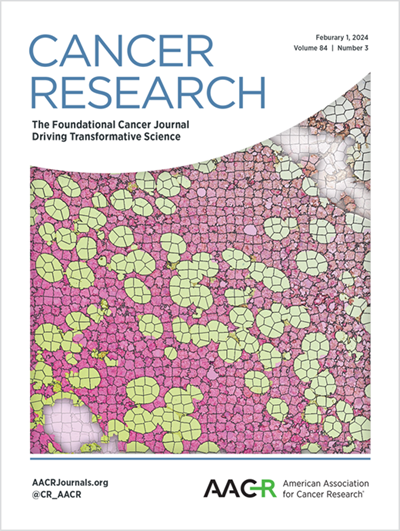Abstract LB309: Differential DNA methylation analysis and functional insights in luminal A and triple-negative breast cancer using FFPE samples
IF 12.5
1区 医学
Q1 ONCOLOGY
引用次数: 0
Abstract
Background: Epigenetic modifications, such as DNA methylation, play a critical role in breast cancer heterogeneity, influencing tumor progression and therapeutic responses. This study investigates differential methylation patterns between luminal A (LumA) and triple-negative breast cancer (TNBC) subtypes using formalin-fixed, paraffin-embedded (FFPE) samples. Functional insights are derived through gene ontology and pathway analyses to understand subtype-specific epigenetic mechanisms. Methods: Genome-wide methylation profiling was performed on FFPE samples of LumA (n=3) and TNBC (n=5) cases using the Illumina Infinium EPIC array. Differentially methylated CpG sites were identified, and gene ontology analysis and pathway enrichment analyses were conducted on genes annotated to differentially methylated CpG sites to identify biological processes and pathways driving subtype differences. Results: Among the 937,690 original probes, 319,514 probes failed in at least one sample and were excluded from further analysis, thus, 618,176 probes were kept for analysis. A total of 28,801 differentially methylated CpG sites were identified between LumA and TNBC cases, with a threshold on methylation differences of 10%. A total of 12,772 genes were associated with the 28,801 significant differentially methylated probes identified between LumA and TNBC. Key enriched gene oncology terms included "small GTPase-mediated signal transduction ", " regulation of trans-synaptic signaling”, and “actin filament organization”, highlighting subtype-specific epigenetic regulation of tumor biology. Pathway analysis revealed significant enrichment of pathways such as "RHO GTPase cycle" and “RAC1 GTPase cycle” in TNBC, consistent with their distinct tumor microenvironments. Conclusions: This study highlights distinct methylation patterns in LumA and TNBC subtypes, reflecting their divergent biological and clinical behaviors. The identified pathways provide insights into potential therapeutic targets and biomarkers for precision oncology and the ability to obtain DNA methylation data from formalin-fixed, paraffin-embedded (FFPE) samples. Future work will validate these findings in larger, independent cohorts and explore their clinical applicability. Citation Format: Yangbo Sun, Khyobeni Mozhui, Jay H. Fowke, Saunak Sen, Karen C. Johnson. Differential DNA methylation analysis and functional insights in luminal A and triple-negative breast cancer using FFPE samples [abstract]. In: Proceedings of the American Association for Cancer Research Annual Meeting 2025; Part 2 (Late-Breaking, Clinical Trial, and Invited s); 2025 Apr 25-30; Chicago, IL. Philadelphia (PA): AACR; Cancer Res 2025;85(8_Suppl_2): nr LB309.LB309:利用FFPE样本对luminal A和三阴性乳腺癌的差异DNA甲基化分析和功能见解
背景:表观遗传修饰,如DNA甲基化,在乳腺癌异质性中起关键作用,影响肿瘤进展和治疗反应。本研究使用福尔马林固定石蜡包埋(FFPE)样品研究了luminal A (LumA)和三阴性乳腺癌(TNBC)亚型之间的差异甲基化模式。功能的见解是通过基因本体和途径分析来了解亚型特异性表观遗传机制。方法:使用Illumina Infinium EPIC阵列对LumA (n=3)和TNBC (n=5)病例的FFPE样本进行全基因组甲基化分析。鉴定差异甲基化CpG位点,并对差异甲基化CpG位点注释的基因进行基因本体分析和途径富集分析,以确定驱动亚型差异的生物学过程和途径。结果:在937,690根原始探针中,319,514根探针在至少一个样本中失败,被排除在进一步分析之外,因此有618,176根探针保留用于分析。在LumA和TNBC病例中共鉴定出28,801个差异甲基化的CpG位点,甲基化差异阈值为10%。在LumA和TNBC之间鉴定的28,801个显著差异甲基化探针中,共有12,772个基因与之相关。重点富集的基因肿瘤学术语包括“小gtpase介导的信号转导”、“跨突触信号传导调控”和“肌动蛋白丝组织”,突出了肿瘤生物学的亚型特异性表观遗传调控。通路分析显示,TNBC中“RHO GTPase cycle”和“RAC1 GTPase cycle”等通路显著富集,这与TNBC不同的肿瘤微环境相一致。结论:本研究强调了LumA和TNBC亚型中不同的甲基化模式,反映了它们不同的生物学和临床行为。确定的途径为精确肿瘤学提供了潜在的治疗靶点和生物标志物,以及从福尔马林固定石蜡包埋(FFPE)样品中获得DNA甲基化数据的能力。未来的工作将在更大的独立队列中验证这些发现,并探索其临床适用性。引用格式:Yangbo Sun, Khyobeni Mozhui, Jay H. Fowke, Saunak Sen, Karen C. Johnson。使用FFPE样本对luminal A和三阴性乳腺癌的差异DNA甲基化分析和功能见解[摘要]。摘自:《2025年美国癌症研究协会年会论文集》;第二部分(最新进展,临床试验,并邀请s);2025年4月25日至30日;费城(PA): AACR;中国癌症杂志,2015;35(8):391 - 391。
本文章由计算机程序翻译,如有差异,请以英文原文为准。
求助全文
约1分钟内获得全文
求助全文
来源期刊

Cancer research
医学-肿瘤学
CiteScore
16.10
自引率
0.90%
发文量
7677
审稿时长
2.5 months
期刊介绍:
Cancer Research, published by the American Association for Cancer Research (AACR), is a journal that focuses on impactful original studies, reviews, and opinion pieces relevant to the broad cancer research community. Manuscripts that present conceptual or technological advances leading to insights into cancer biology are particularly sought after. The journal also places emphasis on convergence science, which involves bridging multiple distinct areas of cancer research.
With primary subsections including Cancer Biology, Cancer Immunology, Cancer Metabolism and Molecular Mechanisms, Translational Cancer Biology, Cancer Landscapes, and Convergence Science, Cancer Research has a comprehensive scope. It is published twice a month and has one volume per year, with a print ISSN of 0008-5472 and an online ISSN of 1538-7445.
Cancer Research is abstracted and/or indexed in various databases and platforms, including BIOSIS Previews (R) Database, MEDLINE, Current Contents/Life Sciences, Current Contents/Clinical Medicine, Science Citation Index, Scopus, and Web of Science.
 求助内容:
求助内容: 应助结果提醒方式:
应助结果提醒方式:


